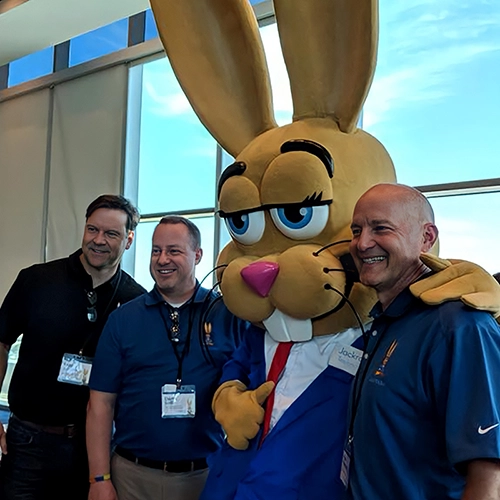You don’t have to be the clown to interject humor into a workplace environment or to use humor in teaching students.
Without humor of the right kind, work can be pretty bland. And when things get bland or routine, people get bored with their jobs and performance suffers.
A recent Robert Half survey on having a sense of humor in the workplace found that 91 percent of executives believe a sense of humor is important for career development and 84 percent feel that people with a good sense of humor do a better job in their careers.
In managing staff, the use of humor can be good for owners and directors and a powerful social intelligence tool – but it needs to be used with skill and purpose.
The benefits of using humor in the workplace
Humor in the workplace is highly beneficial in breaking down barriers and improving performance. Humor creates a more human and authentic environment.
There are boundaries with using humor and they must be observed and managed. Because of those boundaries it’s important to identify what we must understand about humor and to sharpen our understanding to use humor successfully in the workplace.
3 things to consider when using humor in teaching
1. Make yourself familiar with what humor is and how humor works
Humor comes in a plethora of varieties from self-deprecating and observational to slapstick, dark and verbally witty. It isn’t difficult to determine that pulling a chair out from under a colleague is so inappropriate that you may end up laughing alone all the way to unemployment. And overt offensiveness has no place in the workplace. (This includes put-down humor about people’s physical appearance.)
Put-down humor, for example, is a veiled form of superiority. And self-deprecating humor can form the perspective of humbleness and approachability, but if overused can show insecurity and lack of confidence. Inside jokes can be socially bonding but can also be cliquey and alienating to those outside of the ‘group’. Using humor to exert your power over those you manage can turn a positive relationship negative.
Humor can be an outlet for stress and anxiety and is often used to establish a comfort zone.
Humor has been important to us from our birth. Even as infants, giggles and laughter begin to erupt from various stimuli. We progress as we grow and our young brains are able to accept simple and then complex responses and feelings.
As adults there is an obvious dependency on humor for comfort, relief, cheering up, getting attention and for wielding power – just to name a few.
2. Use humor with a purpose
A Southwest Airlines in-plane announcement is perhaps one of the best examples of this: “Southwest Airlines would like to congratulate a first-time flyer on board today who is celebrating his 89th birthday. Ladies and Gentlemen, how about a big round of applause for our pilot.”
The purpose of this announcement is to make people smile, to humanize a depersonalizing experience and to put passengers at ease. It’s also a signal that today’s flight announcements will be interesting, fun and worth listening to. The announcement contains both intellect and empathy. Humor in this context communicates emotional, social and cultural intelligence.
3. Stay on top of it
What’s the reality? Using humor in the workplace carries risk of people questioning your sincerity and professionalism. Because of this, it’s crucial to be on top of your game – focused on the details that will off-set these prejudices.
If you remember the movie, A Few Good Men, the lead counsel draws the questioning of his professionalism by the Navel investigator because of his style of raw humor. Over time she comes to see his skills in the courtroom and can see the purpose of his humor. Unfortunately, in the story, the intent of lead counsel’s humor was not made obvious.
3 rules for using humor in choreography
What about when you’re choreographing routines? Is humor appropriate then?
You’ve probably seen hilarious performances that you loved. Replicating that for your audience is quite enticing. But again – should you? There are also probably more performances using humor that fall flat and don’t engage the audience.
There is definitely value in adding humor into a routine or performance. It adds freshness to the audience experience – and if done well – captures respect for having the skill and nerve to use it.
Humor is intimidating. But you can choreograph it into your routines and performances if you adhere to three ‘rules’, if you will.
-
Get the students on board.
Without the students’ interest, your humor is useless. They have to be active participants who have bought into the humor. Take humor out of the equation if your students aren’t comfortable with your injected humor and won’t commit to it. But once they are committed, the students you teach will probably help shape the choreography and create a more personal and more humorous performance.
2. Tailor your humor to your audience
This is something that is required. Grandparents won’t understand humor geared toward young adults and parent humor may be lost on those who aren’t even married. Routines performed at a school should include student-oriented humor.
Take great care to make any humor you use appropriate to your audience. (This also translates to music and concepts, by the way.) The last thing you want to do is dampen the audience experience by stepping on toes.
3. Seek feedback from others before your opening performance
This is a world of individuals so it follows that humor is just as unique to individuals. If missing the mark on humor is your fear, test it out. Ask a few people to visit and watch your routines, such as friends and other instructors. Don’t invite your organization’s parents or you’ll ruin their performance evening surprise! Listen to when your test guests giggle – and when they don’t – and use their feedback to tweak your humor and enhance your performance.
Be ready for humor
Today’s forward-thinking organizations are embracing more playful workplace cultures.
People who use humor in appropriate and intentional ways are not considered frivolous or flippant, but are agents of behavioral change. They exhibit their intent of building more natural, engaging, authentic work environments.
Those using humor in the workplace successfully are emotionally and socially intelligent members of that culture and are usually genuinely happy, well-adjusted and successful in their work. And that’s no joke.














